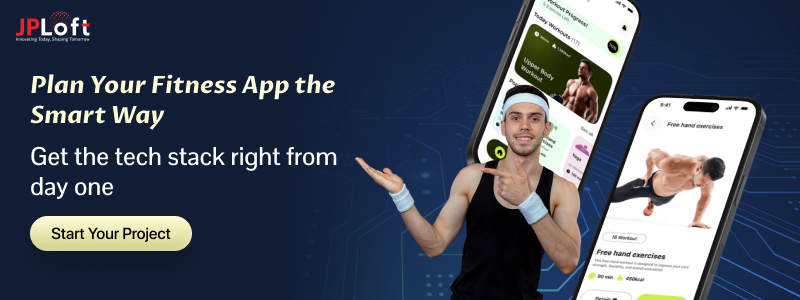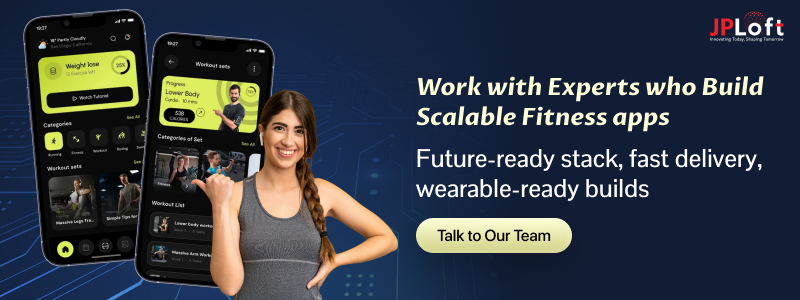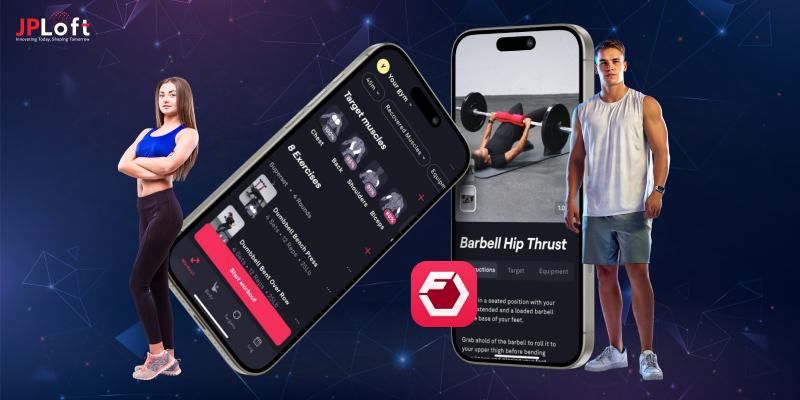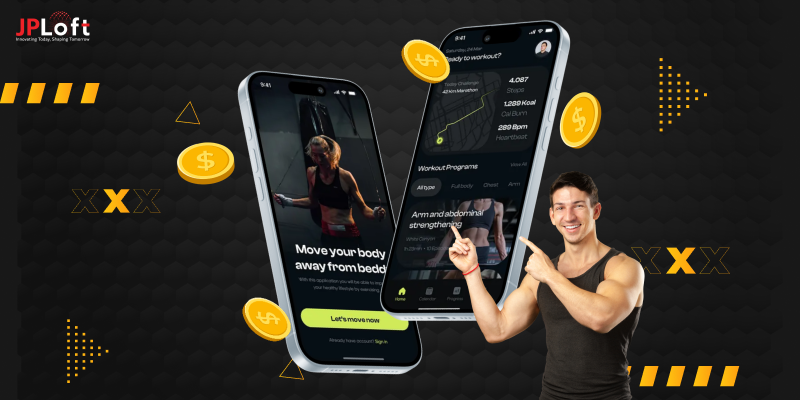Key Takeaways:
The right fitness app tech stack ensures smooth workouts, fast loading, and seamless wearable syncing, giving users a reliable, real-time fitness experience.
Strong backend architecture supports personalized plans, AI workouts, and secure data flow, preventing performance issues as your user base grows.
Choosing scalable tech prevents costly rebuilds later, helping you expand into features like live classes, food logging, social challenges, and AI-based guidance.
Prioritize cross-platform development tools if your goal is faster launch and lower build cost without sacrificing user experience.
Integrating Apple Health, Google Fit, Garmin, and payment gateways from day one provides a competitive edge and boosts engagement and retention.
Cloud infrastructure keeps your app fast during peak traffic, ensures secure storage, and supports future growth without downtime.
"The right foundation determines whether you build a shack or a skyscraper." This wisdom applies perfectly when entering the fitness business; your tech stack is that foundation.
What are the key components of a fitness app tech stack? It's the combination of programming languages, frameworks, databases, and cloud services that power everything from workout tracking to real-time heart rate monitoring.
Many founders rush into development excited about features, only to discover their chosen technologies can't handle wearable integration or crash under user load. The stakes are high; fitness app users expect flawless performance during workouts, seamless device syncing, and bulletproof data security.
This checklist breaks down frontend, backend, database, cloud infrastructure, and integration layers, helping you make informed decisions that align with your app's goals, budget, and scalability needs for long-term success.
Let’s begin together.
Basics of Tech Stack
The primary question that lies here to start before the fitness app tech stack is what it is.
A mobile app tech stack can be referred to as a set of tools, programming languages, and technologies used to build and run a mobile application.
Let’s evaluate what comes in it, with the table below.
|
Tech Stack Element |
One-Line Description |
|
Frontend (Client-Side) |
The part users see and interact with through screens, buttons, and UI elements. |
|
Backend (Server-Side) |
Handles logic, data processing, authentication, and app functionality behind the scenes. |
|
Database |
Stores and organizes all app data like user profiles, activity logs, and content. |
|
APIs & Integrations |
Bridges the app with external services like payments, maps, and health sensors. |
|
Mobile Frameworks |
Tools to build Android, iOS, or cross-platform apps efficiently. |
|
Cloud Services |
Provides hosting, storage, and remote servers to keep the app running smoothly. |
|
Authentication & Security |
Protects user data and manages login, permissions, and encrypted access. |
|
DevOps & Deployment |
Tools and processes for testing, launching, and updating the app smoothly. |
|
Analytics & Monitoring |
Tracks performance, user behavior, and app health in real time. |
|
Notifications & Messaging |
Tools to send alerts, reminders, and updates that keep users engaged. |
If you do not want to make tech stack a real challenge to make a fitness app, then learning the right selection procedure, detail on the tech stack and key components is crucial.
Hence, let's get ahead with the prompt components to include in the fitness app tech stack in the following section.
A Detail on Fitness App Tech Stack
A solid tech stack for a fitness app gives your product the backbone needed to perform smoothly, scale confidently, and deliver a great training experience.
To build a fitness app, you need to start with the frontend that powers workouts, dashboards, and progress screens on Android and iOS. Behind that sits the backend, which manages APIs, databases, and cloud services, handling user data, health metrics, sessions, nutrition plans, and trainer communication.
Add APIs for wearables, GPS tracking, and push notifications to keep users motivated and consistent. Security, analytics, and deployment tools complete the picture. When chosen well, this stack keeps your fitness app fast, stable, and future-ready.
Let’s learn about the fitness app tech stack in detail below.
1. Frontend (Mobile App Layer)
The frontend is what users will be interacting with every single time they open your fitness app. The workout screens guide them through routines, and the progress trackers show muscle gain, calories burned, and habit streaks.
Additionally, it also shapes the onboarding experience, from fitness goal selection to personal training preferences and program picks. Using frameworks like Flutter, React Native, Swift, or Kotlin ensures high-performance animations, responsive charts, fluid transitions, and offline workout access for days when users train without internet.
When done well, the frontend feels motivating, fast, and frictionless-the kind of interface that keeps users coming back rather than switching to the next fitness app in the store.
2. Backend (Server Logic)
The backend is where all the fitness intelligence lives: personalized training schedules, calorie calculations, macro counting, habit streaks, step sync, and dynamic workout progression based on users' performance.
Platforms such as Node.js, Laravel, Django, or Python will make sure that workouts are delivered without lag, user plans are updated in a second, and subscriptions and in-app purchases go seamlessly.
A strong backend also supports recommendation engines like push-based "Today's workout" or "Recovery day suggestions," keeping users engaged with fresh, timely guidance. It's the backbone that moves the experience beyond generic exercise lists into a personalized fitness journey.
3. Database
Fitness applications collect one of the richest forms of behavioral and health data. This includes meal logs, steps, heart rate zones, workout intensity, reps & sets history, personal PRs, water intake, and rest days.
The database keeps all of this structured, secure, and instantly retrievable. With MySQL, PostgreSQL, or MongoDB, the app will be able to handle thousands of real-time log entries without slowing down.
Good architecture means no lag when someone scrolls months of workout history, checks their body measurements, or pulls up personal bests. Solid indexing also supports AI-based recommendations that rely on past performance. To put it simply, a robust database helps users trust the app with their fitness story and come back to track the next chapter.
4. APIs & Integrations
In the world of fitness, integrations make everything smarter and more useful. APIs allow syncing of Google Fit, Apple Health, Fitbit, Garmin, and Strava to pull live step counts, calories burned, heart data, and sleep metrics right into the app.
Thus, another parameter in the guide of fitness app tech stack is APIs and integration. They connect payment gateways for subscriptions, video streaming services for workout lessons, and nutrition APIs for food logging and macro breakdown.
Otherwise, users would be forced to key in all data manually-and they would quit in droves. REST or GraphQL APIs forge seamless bridges between all systems, allowing users to track progress friction-free. This is the invisible fuel powering a connected, automated fitness experience.
5. Wearable & Health Device Sync
Wearable support is a core expectation of fitness these days. Whether it's strain score from WHOOP, HRV from Apple Watch, heart rate from Garmin, or VO2 max from Fitbit, users want their devices to talk to your app.
By syncing these metrics, you can show smarter insights such as recovery readiness, cardio trends, strength improvements, and sleep quality scoring.
You can also unlock features such as live heart-rate zones during workouts, post-training pacing breakdowns, and more. When your app connects seamlessly with wearables, it's a real coach, not just a digital notepad.
6. Cloud Hosting & Infrastructure
Fitness applications tend to face peak usage either in the early morning or evening; thus, infrastructure has to bear the load spikes when thousands log their workouts simultaneously.
Cloud platforms like AWS, Google Cloud, and Azure ensure fast loading of workouts, smooth video streaming, real-time leaderboard updates, and seamless syncing with wearables and trackers.
They also include CDN delivery for media, automated backups of progress data, and scalability when joining new challenges or group programs. Strong cloud architecture ensures that a fitness app never feels slow, even during massive community events such as 30-day transformation challenges or global step competitions.
7. Authentication & Security
Fitness apps store health history, biometric statistics, eating habits, location logs, and sometimes even medical-adjacent data, like injury notes and heart rate patterns. Strong authentication secures this personal information.
Social login creates convenience, biometric login builds trust, and token authentication ensures only the right user sees their progress. This will help you ensure relevant mobile app security in your app.
HIPAA-style data handling and secure API communication create peace of mind. When users know their fitness journey is private and protected, they're far more willing to share real progress and stick with the app long term.
8. Push Notifications & Messaging
Results in fitness come from consistency, and notifications help users be more disciplined. Smart push notifications remind them to train, drink water, stretch, rest, meditate, or log meals.
They celebrate milestones, streaks, and PRs-users are acknowledged and motivated. Two-way messaging opens space for personal trainers, group challenges, and AI coaching responses.
When done properly, notifications feel like a supportive coach, not spam. They drive engagement, retention, and habit formation.
9. Analytics & AI
Analytics help you understand usage patterns-when people work out, what programs they choose, when they drop off, and what motivates them to return.
AI in fitness apps can then turn that data into personalized plans, adaptive routines, smart rest day suggestions, recovery alerts, calorie guidance, or weight-loss tracking assistants.
Machine learning can detect behavior changes, suggesting intensity shifts or encouraging streak recovery. In this crowded fitness space, the apps that feel personal-like they see and understand the user-always win. Connecting with a leading AI app development company can be helpful here.
10. DevOps & Deployment
Continuous updates matter: new exercise videos, bug fixes, progressive overload features, challenge modules, fresh UI elements. DevOps ensures these updates roll out seamlessly without breaking the experience.
Automated tests catch issues before users do, and CI/CD pipelines support frequent releases; monitoring tools ensure everything stays fast and stable.
Smoother updates in fitness apps mean less interference with a user's continuity in training rhythm, which is their key to loyalty. When updates feel effortless, users stay-and training businesses scale without tech headaches.
Now, let's switch over to the cost section below.
What is the Cost to Integrate a Tech Stack in a Fitness App?
Additionally, when it comes to deciding the cost to build a fitness app, the tech stack is a strong factor here. Overall, the cost to integrate the tech stack lies between $2000 to $30,000+, depending on the features and many other factors.
Let’s summarize the fitness app tech stack along with the cost in the table below.
|
Component |
What It Does |
Estimated Cost Contribution |
|
Frontend (iOS/Android UI) |
Builds workout screens, progress charts, video UI, user experience |
$5,000 – $12,000 |
|
Backend (Core Logic) |
Handles workouts, meal plans, subscriptions, chat, logs |
$6,000 – $15,000 |
|
Database |
Stores workouts, user profiles, health logs, achievements |
$2,000 – $5,000 |
|
APIs & Integrations |
Connects payments, maps, trainers, video systems |
$1,000 – $4,000 |
|
Wearable Sync (Apple/Google/Fitbit) |
Imports heart rate, steps, calories, sleep data |
$2,500 – $8,000 |
|
Cloud Hosting & Infrastructure |
Servers, scaling, media storage, load balancing |
$1,500 – $5,000 yearly |
|
Authentication & Security |
Secure login, data encryption, privacy controls |
$1,000 – $3,500 |
|
Push Notifications & Messaging |
Reminders, streak alerts, habit nudges, chat |
$500 – $2,000 |
|
Analytics & AI |
Performance tracking, insights, and personalization |
$2,000 – $8,000 |
|
DevOps & Deployment |
CI/CD, testing, updates, stability |
$1,000 – $3,000 |
When you start an online fitness business, one of the first questions that might trouble you is “why”.
Similarly, when you select an appropriate tech stack for your fitness app, the question that might strike you is why! What's the need to select a suitable tech stack for your fitness app? Let’s check it out in the following section.
Let’s switch to the following section to learn more.
Why Selecting the Right Tech Stack for a Fitness App Matters?
There are many reasons that you should choose a suitable tech stack for a fitness app. Such as It helps in improving the app development process, helps to achieve the goal and purpose of creating an app effectively, as well as helps to build a solid base on which the infrastructure depends.
Let’s check it all out in this section.
1] Performance During Workouts
Your app needs to track workouts, monitor heart rates, and stream videos without lagging or crashing.
If your tech stack can't handle real-time data processing smoothly, users will delete your app the moment it freezes during their morning run. Battery drain is another killer; pick technologies that won't have users constantly hunting for chargers.
2] Handling Growth
Start with 100 users today, wake up to 10,000 tomorrow. Your tech stack decides if your app can handle that spike or if it collapses under pressure.
Poor choices mean expensive rebuilds later when you want to add features or expand your user base.
3] Connecting with Devices
Users want their Apple Watch, Fitbit, and phone to talk to each other. Some frameworks make these integrations easy; others turn them into nightmares.
If your app can't sync with popular wearables, you're already behind the competition.
4] Getting to Market Fast
Submitting an app on iOS or publishing an app on the Android, you need to build it separately. Building for iOS and Android separately, and you're looking at double the time and cost.
Cross-platform options let you launch faster, but might sacrifice some performance. In fitness apps, being first matters; users stick with what they already have.
5] Managing Costs
Popular tech stacks mean you can find developers more easily and cheaply. Go niche, and you'll pay premium rates for specialists while struggling to hire.
Factor in ongoing app maintenance costs, too; some choices are cheap upfront but expensive to maintain.
6] Protecting User Data
You're handling weight, health metrics, location data, and sensitive stuff. A weak tech stack leaves you vulnerable to breaches and compliance headaches.
One security failure can destroy your reputation overnight in an industry built on trust.
After considering the reasons to select a suitable fitness app tech stack, let's consider the factors impacting your decision towards a fitness app tech stack in the following section.
Factors to Consider While Selecting Fitness App Tech Stack
When you wish to create top fitness apps, its significant to consider the right tech stack, and selecting them includes several factors.
Here is the list of the factors that you should consider for selecting the right fitness app tech stack.
► The Types of Apps and Their Features
One of the core factors is the types of apps and their related features. Here is the workout coaching app, nutrition tracker, habit builder, or full AI fitness platform. Along with this, if you want to integrate the advanced features, then the complicated tech stack should be selected.
A fitness app requires instant timers, while a yoga app needs video stability, and each goal shifts tech needs
► Selection of Platform (iOS, Android, or Both)
The cross-platform frameworks, such as Flute or React Native, help launch faster. Here, you need to select the type of platform and then the tech stack supporting that platform.
You should note that the native tech supports premium fitness experiences, and selecting the platform early can save you from rebuilding later when the user demand grows.
► Wearable & Health Data Integration
Fitness users expect automatic syncing from smartwatches and trackers. That means secure SDKs, accurate data handling, and smooth background syncing.
For the fitness app tech stack, checking for the wearables as well as health data integrations is crucial. Apps without device support feel outdated, and users switch quickly.
► Scalability & User Growth Plans
A stack built for scale ensures your app handles thousands of users logging workouts at the same time. Think January fitness rush or big challenge campaigns.
Additionally, for the fitness app tech stack, if you plan to go global or add social features, scalability isn’t optional.
► Real-Time Tracking & Engagement
Workout pacing, heart-rate zones, streak counters, and trainer chats need real-time tech. Fitness motivation dips fast if performance data lags.
The Real-time tech adds excitement and accountability, key to retention.
► Budget & Development Timeline
Your stack affects cost, speed, and go-to-market time. Cross-platform saves money; native gives deeper performance.
In this guide to fitness app tech stack for 2025, you must have learned that balancing vision with budget avoids feature compromises later.
► Data Security & Compliance
Fitness apps store sensitive info, body stats, routines, and sometimes medical-adjacent data. Your tech stack must encrypt everything and handle secure sign-ins.
For the mobile app security, trust is crucial; a single privacy slip destroys user confidence.
► Long-Term App Vision
Planning for AI trainers, nutrition dashboards, or group competitions later means choosing tech you can expand easily.
Future-proof tech choices eliminate rebuilds and help your app evolve like top players (Fitbit, MyFitnessPal, Strava).
► Offline Usage Requirements
Gyms, outdoor runs, and travel don't always offer strong internet. Offline support keeps workouts functional and logs accurate.
Apps that fail offline lose serious user trust, especially weight trainers and runners.
► Third-Party Integrations
Fitness apps depend on payment gateways, video streaming, wearable APIs, mapping tools, and analytics systems.
Flexible integration-friendly stacks help you grow features without redesigning the core system.
Continuing with the factors impacting the selection of fitness app tech stack, let's learn about the process of selecting a suitable tech stack for your fitness app, below.
How to Choose the Suitable Tech Stack for Your Fitness App?
You can select a suitable tech stack for the fitness app by identifying the purpose of the app, required features, complexity, and size of the app, platforms on which the app is launched, users’ preferences related to what they expect, and much more.
Let’s consider the process to select the best fitness app tech stack in 2025 for your app, below.
Step 1: Identify Core Features and Goals for Your App
List all the features you want in your app: workout tracking, video streaming, social sharing, wearable integrations, etc. Make a list of must-have features and nice-to-haves for your initial launch. This clarity prevents choosing technologies that can't support your vision or paying for capabilities you don't need.
Step 2: Identify Your Target Audience and Platforms
Determine whether iOS or Android is most in use by your users, and what wearables are used. Research demographics, locations, and device preferences of your target market. This will give you an idea if you need native development, cross-platform solutions, or web-based apps.
Step 3: Evaluate Your Budget and Timeline
Estimate budget for development, hosting, licenses, and ongoing maintenance. Project realistic timelines for launch according to market opportunity and competition. Budget will often rule options out very quickly; native development on both platforms is considerably costly compared with cross-platform solutions.
Step 4: Assess Your Team's Technical Capabilities
Take inventory of the skills and experience of the people on your current team with various technologies. Consider hiring timelines if you need specialists in any particular frameworks or languages. Building with familiar technologies reduces errors and speeds development, even if they're not theoretically "optimal."
Step 5: Research Technology Options for Each Layer
Look into frontend frameworks-React Native, Flutter, Swift, Kotlin-back end solutions such as Node.js, Python, Ruby-databases including PostgreSQL and MongoDB-cloud providers such as AWS and Google Cloud. Study the case study of different similar fitness apps and find what worked for them. Make a shortlist based on what options would be feasible for each part of your stack.
Step 6: Evaluate Integration Capabilities
Ensure these technologies in your shortlist support integration with HealthKit, Google Fit, payment gateways, and any other third-party APIs you want to use. If SDKs and libraries are available, test connecting with popular fitness wearables. The lack of such integrations will imply custom development work-increasing costs and timelines.
Build a Winning Fitness App Tech Stack with JPLoft
Choosing the right tech stack for your fitness app can feel overwhelming with countless options available. JPLoft, a leading fitness app development company, simplifies this process by combining technical expertise with deep industry knowledge.
They don't believe in one-size-fits-all solutions; the team analyzes your unique requirements, target audience, budget, and timeline before recommending technologies that match your business goals, not just trends.
JPLoft has delivered fitness apps across various niches, from workout tracking and nutrition planning to live classes and AI-powered coaching. Their end-to-end development expertise spans frontend and backend technologies, cloud infrastructure, wearable integrations, and security implementations.
What sets us apart is our focus on building future-proof solutions with scalable, modular architecture that allows easy feature additions without expensive rebuilds. With JPLoft's proven track record and comprehensive approach, you get a robust tech stack that ensures smooth user experiences and positions your app for long-term success in the competitive fitness market.
Conclusion
Choosing the right fitness app tech stack is not just a technical step; it's the foundation of your product’s performance, scalability, and user trust. A well-built stack makes workouts smooth, data accurate, and wearable syncing effortless, while also supporting personalization, security, and long-term growth.
As the fitness market evolves with AI, community features, and smart device integrations, the right technology decisions today prevent costly rebuilds tomorrow. Build thoughtfully, test thoroughly, and keep the user journey at the core, that’s how your fitness app earns loyalty, engagement, and real results in a competitive digital wellness space.
FAQs
A fitness app typically uses Flutter/React Native, Node.js or Laravel, Firebase or PostgreSQL, wearable APIs, and cloud hosting for smooth performance and scalability. This stack supports rich UI, fast data syncing, and seamless wearable integration. It also ensures your app can grow with advanced features like AI-workouts and live classes.
Users expect real-time fitness data from Apple Watch, Fitbit, Garmin, and Google Fit. Wearable syncing makes your app smarter, more accurate, and more engaging. It enhances personalization by tracking heart rate, steps, calories, and sleep. Apps without wearable support feel outdated fast in the fitness market.
Fitness app tech stack setup typically ranges from $2,000 to $30,000+, based on features, complexity, and integrations. Costs increase with real-time tracking, AI recommendations, and advanced analytics. Plan your budget early to avoid compromises during development.
Yes. Cloud hosting ensures secure data storage, fast loading, and smooth sync across devices. It supports peak workout traffic, live sessions, leaderboards, and video content. Cloud-based apps scale easily as your user base grows.
A Stack on Apple Fitness lets you line up multiple workouts or meditations to play back-to-back, creating a seamless routine without stopping to choose each session individually.













Share this blog